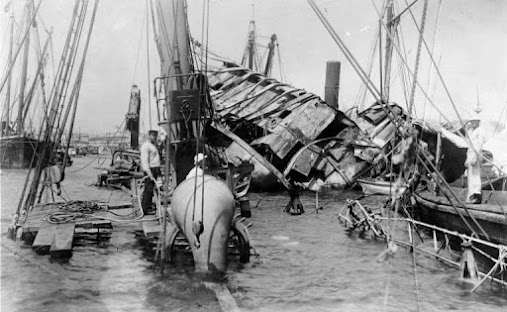The Spanish American War began when more than 250 Navy crewman lost their lives in an explosion on one of America's first battleships. When the ship was brought up from the sea in 1912, pieces were distributed throughout the United States, to be used as memorials. One such piece went to Danville, and another to Scranton. Above photo shows the wrecked Maine, Havana Cuba Decorated May 30 1902 [Memorial Day] by order of President Palma
The USS Maine, a second-class battleship, it was commissioned in September 1895 at the New York Navy Yard. The ship spent the next few years patrolling off the east coast of the United States and in the Caribbean area. In January 1898 the Maine was sent to Havana, Cuba, to protect U.S. interests during local unrest. On February 15th 1898, at 9:20pm, a huge explosion occurred on the forward part of the ship, where the ammunition had been stored. Two hundred and sixty six men, mostly enlisted personnel sleeping in the blast area, were killed.
The explosion killed 252 men, with 8 more dying in hospitals later. Of the two-thirds of the crew who perished, 200 of the bodies were recovered and only 76 were identified.
A four week long Naval investigation concluded that the cause had been a mine or torpedo, based on a panel of the lower hull appearing to have been blown inward.
With American's chanting the war cry "Remember the Maine", the United States declared war, on April 2 1898. More than 415,000 men served in the Spanish American War.
Pennsylvania was represented by 15 regiments, a battery of artillery, and a governors Calvary troop. 5,000 were killed in combat, and another 28,000 died from disease.
The ship being raised in 1911
The Maine was raised in 1911, as part of an effort to clear the harbor. Charles E. Wray, a Sunbury native, witnessed the raising while enlisted in the Navy. Undamaged pieces of the ship were salvaged and distributed throughout the United States, in an effort to Remember The Maine.
The relics were donated by the Navy department on the condition that they be mounted and preserved as a memento and patriotic inspiration to coming generations; if not, they were to revert automatically to the government.
The ship was then towed out to sea and sunk in deep waters in the Gulf of Mexico, with appropriate ceremony and military honors.
The vessel's mainmast is located in Arlington National Cemetery, next to the graves of many of the crew who perished in the attack .The forward mast was put up at the Naval Academy in Annapolis Md, and the anchor from the ship is on display in downtown Reading.
Danville procured a small piece of metal from the ship in 1936. Abigail Geisinger paid to have the tablets mounted into a stone monument.
When the metal arrived in Danville in 1915, it was displayed in the window of John Jacob's Sons store on Mill Street. The monument, when completed, was placed in Riverside Park, where it remained until 1936. In 1936 the monument was moved to the east end of Memorial Park. In 1995 the monument was moved again, to the west end of the park, near the monument to the veterans of the Spanish American war.
The city of Scranton, which at the time was a bustling coal and rail center, received the 10 inch shell and porthole cover, recovered from the wreckage. The artifacts, awarded to the local Navy League, were placed in a memorial at Nay Aug Park in 1913.In 1912 when the ship was raised, the original findings were confirmed. But in 1976, a new investigation declared that the explosion had been internal.
===========
READ MORE
==========
https://www.history.navy.mil/content/history/museums/nmusn/explore/photography/ships-us/ships-usn-m/uss-maine-1895-1898.html
James B. Scott, H.B. Alworth, H.C. Brown, William Garvin, C.C. Kohler, Edward Houk, and Edward Burns, all of the Wilkes Barre area, went to Washington DC in March of 1912 to serve as honorary pall bearers. All of the men were members of the Henry W. Lawton Camp of Spanish-American War Veterans.
May 1912
The Navy League presented the artifacts to the city of Scranton on Memorial Day, 1913.
Paul Loftus, a marine onboard the Maine, was born in Scranton Pa. He survived the explosion.











No comments:
Post a Comment
I'll read the comments and approve them to post as soon as I can! Thanks for stopping by!